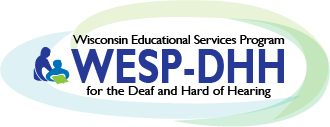Deaf and hard of hearing means a decreased ability to detect sound in one or both ears with or without amplification, whether permanent or chronically fluctuating, which adversely affects a child’s educational performance. This includes academic performance, speech perception, speech production, or communication including language acquisition or expression. A current evaluation by an audiologist licensed under ch. 459, Stats., shall be one of the components for an initial evaluation of a child with suspected hearing loss. A teacher of the deaf or hard of hearing licensed under s. PI 34.050 must be a member of the IEP team when determining eligibility. PI 11.36 (4), Wis. Admin. Code For more information and guidance on implementing the updated rule, see the "Deaf and Hard of Hearing Criteria" section of this web page. For the 2022-2023 school year, 1,657 students (0.2%) of total public school enrollment (822,804 students) were identified as being deaf or hard of hearing. The 1,657 students who were deaf or hard of hearing made up 1.4% of all students with IEPs (122,187). In Wisconsin, IEP teams are not required to identify secondary or tertiary impairment areas and are only required to submit a “reporting” disability and may also report an “other” disability category. Thus the number of students identified as having an “other” disability category of deaf or hard of hearing is not reflected in this data. To view additional data including district level information, go to the WI DPI public WISEdash portal. In Wisconsin, like many other states, we see district data demonstrating race-based patterns of identification for some impairment areas compared to others. Although districts rarely demonstrate these patterns in the area of deaf and hard of hearing, as an equity issue, we strongly encourage all districts to disaggregate their special education data to ensure evaluation practices and procedures are culturally responsive and address bias when conducting and analyzing assessments used to make eligibility decisions. Go to the DPI Culturally Responsive Problem Solving web page for more information. §300.304 of the Individuals with Disabilities Education Act (IDEA) outlines two purpose of special education evaluations (i) Whether the child is a child with a disability; and (ii) The content of the child’s IEP, including information related to enabling the child to be involved in and progress in the general education curriculum (or for a preschool child, to participate in appropriate activities). The disability category criteria IEP forms only assist IEP teams with (i) and are not sufficient in completing an evaluation and developing a student’s IEP. To ensure compliance with implementing a full, individual, and comprehensive evaluation, go to the Wisconsin DPI Comprehensive Special Education Evaluation web page.
Incidence
Disproportionality
Deaf and Hard of Hearing Criteria
Worksheets and Guidelines
Other Special Education Resources
We encourage you to sign up for our email list. Directions on how to sign up can be found on the DPI email lists web page. Scroll down to Special Education and click on the “collabsupportlist," "wesp-dhh-professionals," or "wesp-dhh-families" email list.



